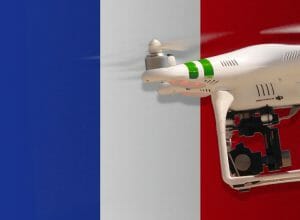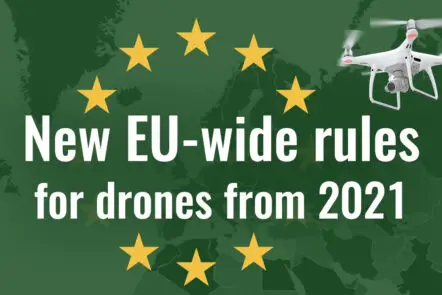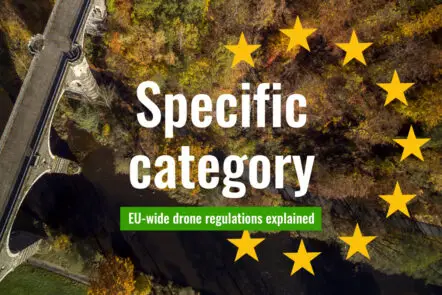Drone regulations in France
Last update on 15.05.2023 | 40 Kommentare

France is a multifaceted country that has many stunning locations for aerial images. In this post, you will learn about the rules you need to consider as a drone pilot in France.
The EU Drone Regulation has been in force in France since December 31, 2020. This has largely harmonized the rules for remote pilots. You only have to register as an operator in one European country and your EU drone license is also recognized across countries. France had already introduced new rules a few months earlier, setting the course for implementation of the EU regulations.
The AlphaTango portal, where drone operators can register, has already been introduced.
Overview of the European rules that apply in France
In France, the regulations of the European Aviation Safety Agency (EASA) apply. The following is a summary of the key facts. For a complete overview, read our article on the new EU drone regulation.
National peculiarities in France
Each country can define certain aspects of its drone regulations. For France, the following requirements apply in addition to the European regulations.
Remote ID
From 29 June 2020, drones weighing 800 grams or more must be equipped with a signaling device. It transmits the drone’s identification and information on the current flight (coordinates, speed, course) at regular intervals by radio signal (WIFI). The identification is stored at AlphaTango so that the authorities have access to it. The penalty for not having a signaling device starts at 135 euros. Exceptions are made for model and sports pilots and unmanned flight systems that are only used indoors.
In the meantime, DJI has released an update for some drone models that enables remote identification in compliance with the law. To do so, the devices must be updated via the DJI GO 4 app or DJI Assistant 2. On AlphaTango, the identification number consisting of 1581E and the serial number of the controller can then be entered. According to the blog of the electronics chain Studiosport, the update is currently available for DJI Mavic 2 Pro and Zoom, DJI Matrice 300, DJI Phantom Pro 4 V2.0 and Pro + V2.0. It is expected that it will also be available for the following models: DJI Mavic 2 Enterprise Zoom, DJI Mavic 2 Enterprise Dual, DJI Phantom 4 RTK, DJI Phantom 4 Multispectral, DJI Matrice 200 V2, DJI Matrice 210 V2, DJI Matrice 210 V2 RTK.
Permission to take aerial photographs
Since 01.01.2023, it is no longer necessary to obtain permission to take aerial photographs.
Another peculiarity in France is that remote pilots must submit a form if they want to take aerial photographs. All drone pilots (private and commercial) must fill out this document if they want to take pictures or videos of the light spectrum visible to humans. So this rule applies to owners of pretty much all camera drones.
To get permission, fill out the CERFA-12546 form. If you are a foreigner, send the document to the Direction de la sécurité de l’aviation civile (DSAC) Northern Office at least 15 days before the intended flight. Please also submit your EU drone licence and identity card. The permit is valid for three years.
You can find the form and the necessary contact details here.
It is advisable to carry proof that you have sent the form. Apparently, the presence of the document is sometimes checked by the gendarmerie.
Further rules for the operation of drones in France
A flight ban on drones applies in the entire metropolitan area of Paris. In other cities, too, you are only allowed to fly your drone on private property. In addition, drones cannot be used near nuclear power plants, military facilities, historical monuments, or in national parks. You can see no-fly zones in the map linked above. The colors have the following meaning:
- Red: drones are not allowed to fly
- Pink: Maximum flight altitude of 30 meters
- Orange: Maximum flight altitude of 50 meters (with a lighter shade of orange 60 meters)
- Yellow: Maximum altitude of 100 meters
Good to know
The rules listed here also apply to the overseas territory of French Polynesia.
Frequency determinations: 100 mW for the 2.4 GHz frequency
We have researched the listed drone regulations for France to the best of our knowledge. We can not guarantee the correctness of the information. If you want to be on the safe side, please contact the competent aviation authority. Alternatively, you can also ask the embassy in your country for further information about the regulations. Please leave us a comment when you receive news and/or gain experience with your copter in France!
 EU-wide drone regulations: Classes of drones explained
EU-wide drone regulations: Classes of drones explained
 New EU-wide rules for drones from 2021
New EU-wide rules for drones from 2021
 EU-wide drone regulations: The Open category explained
EU-wide drone regulations: The Open category explained
 EU-wide drone regulations: The Specific category explained
EU-wide drone regulations: The Specific category explained
Paris it’s possible to fly respecting the best practices?